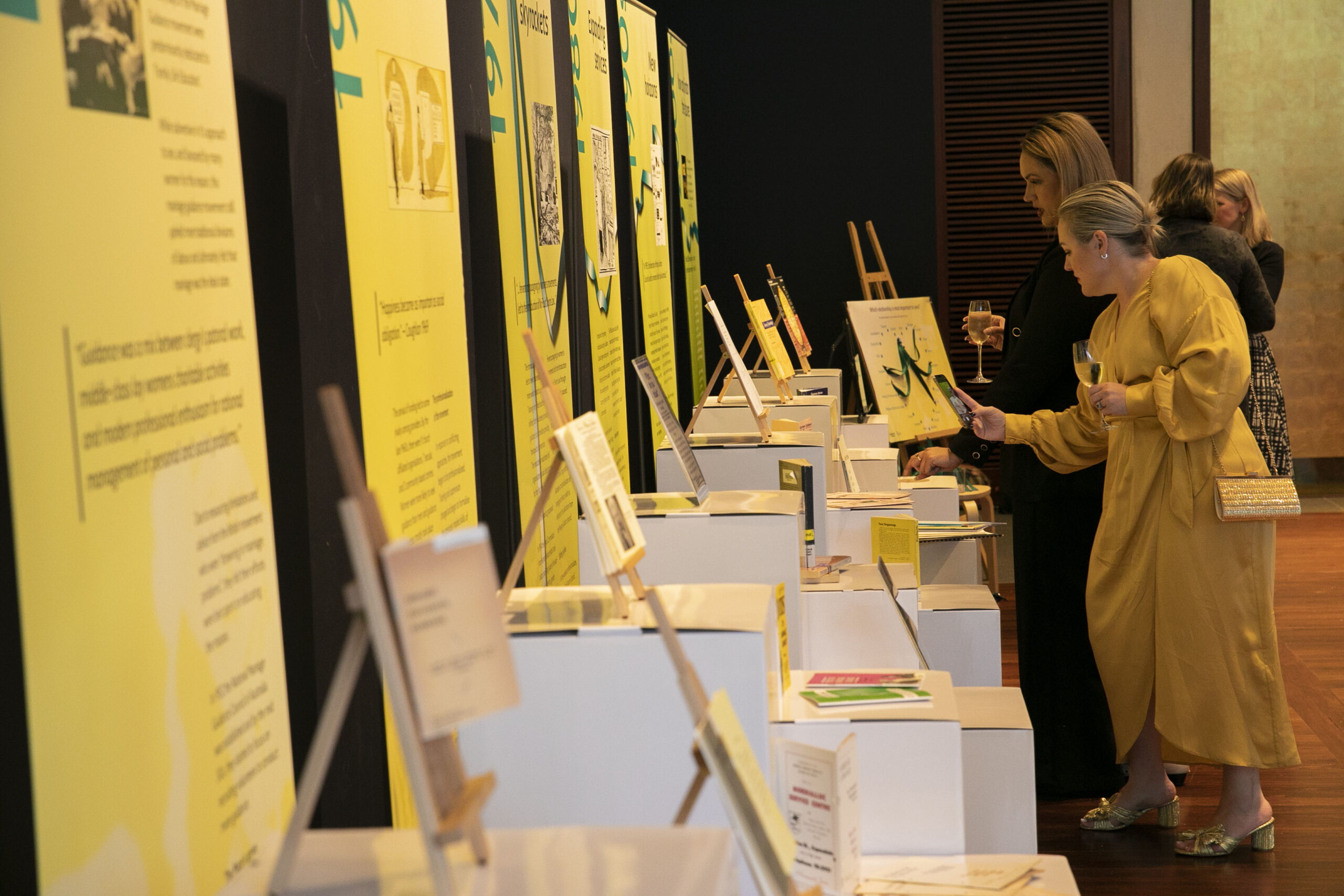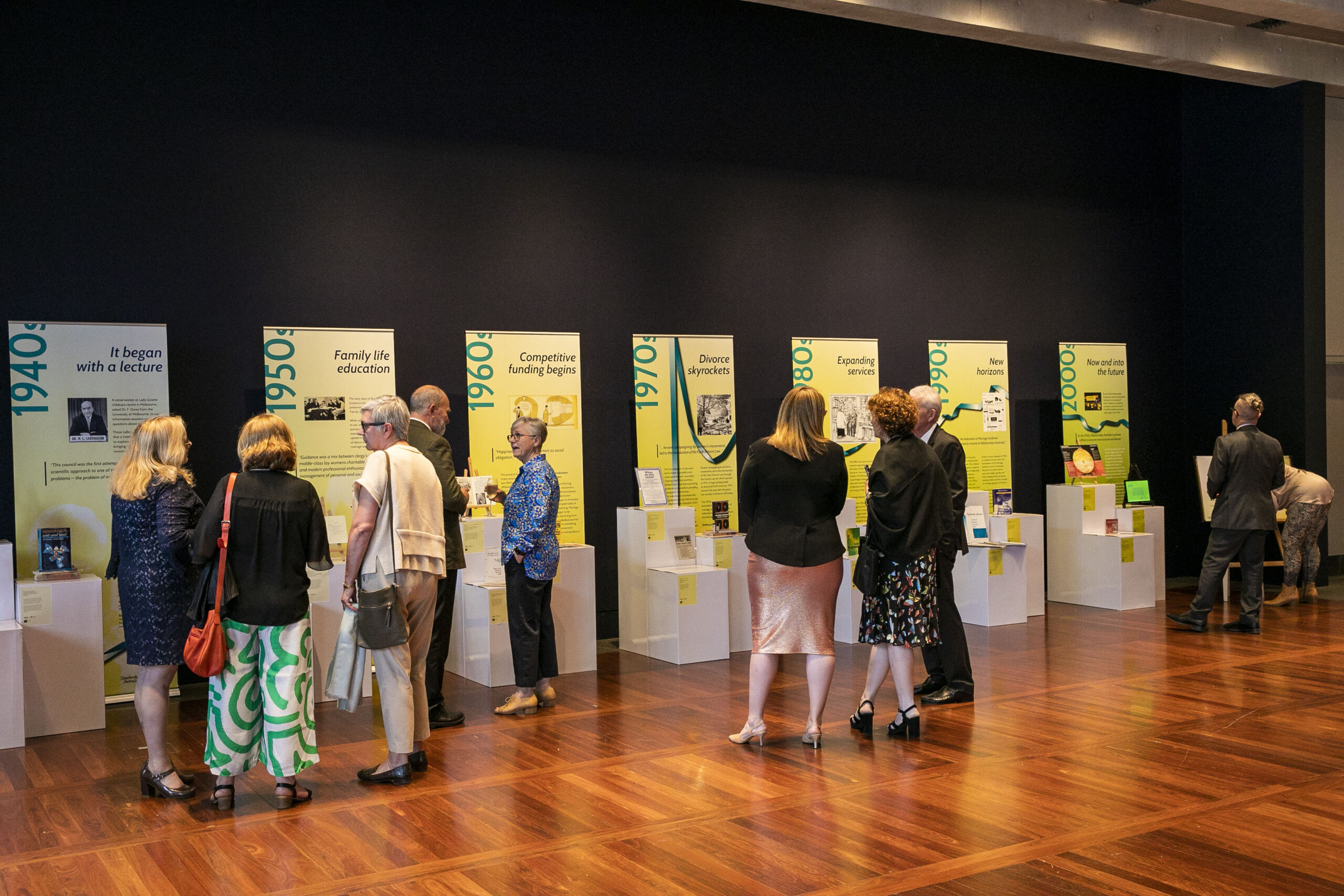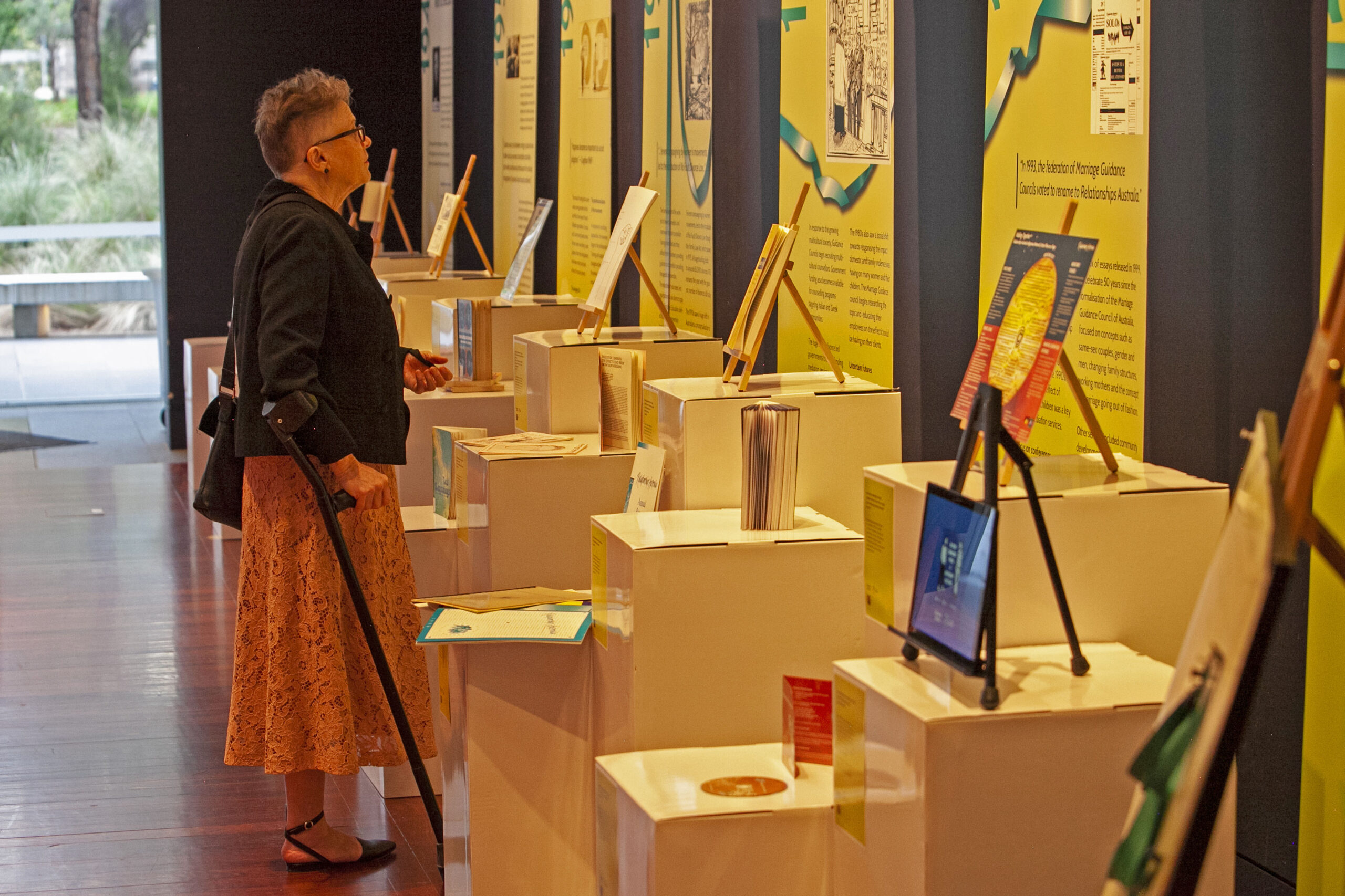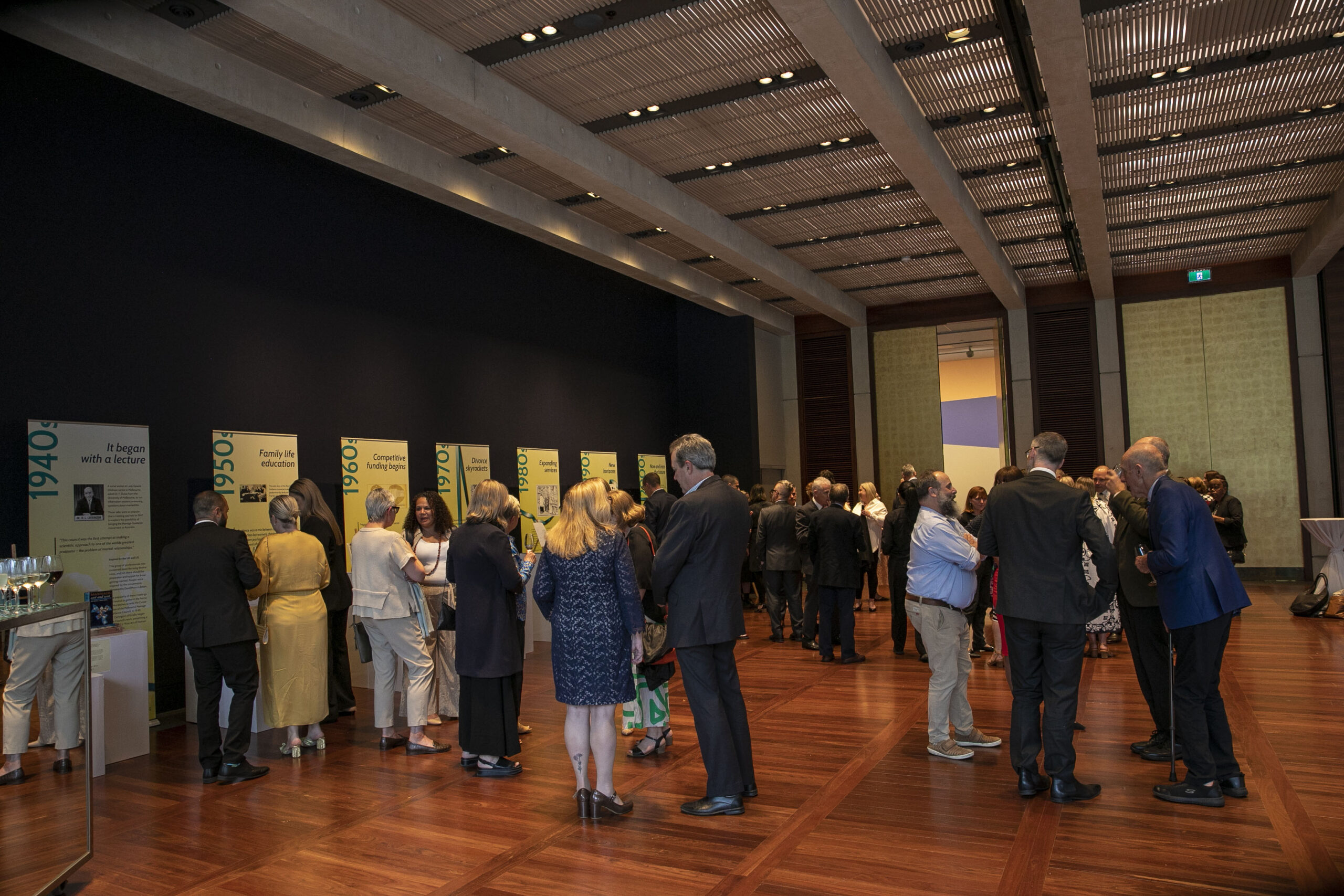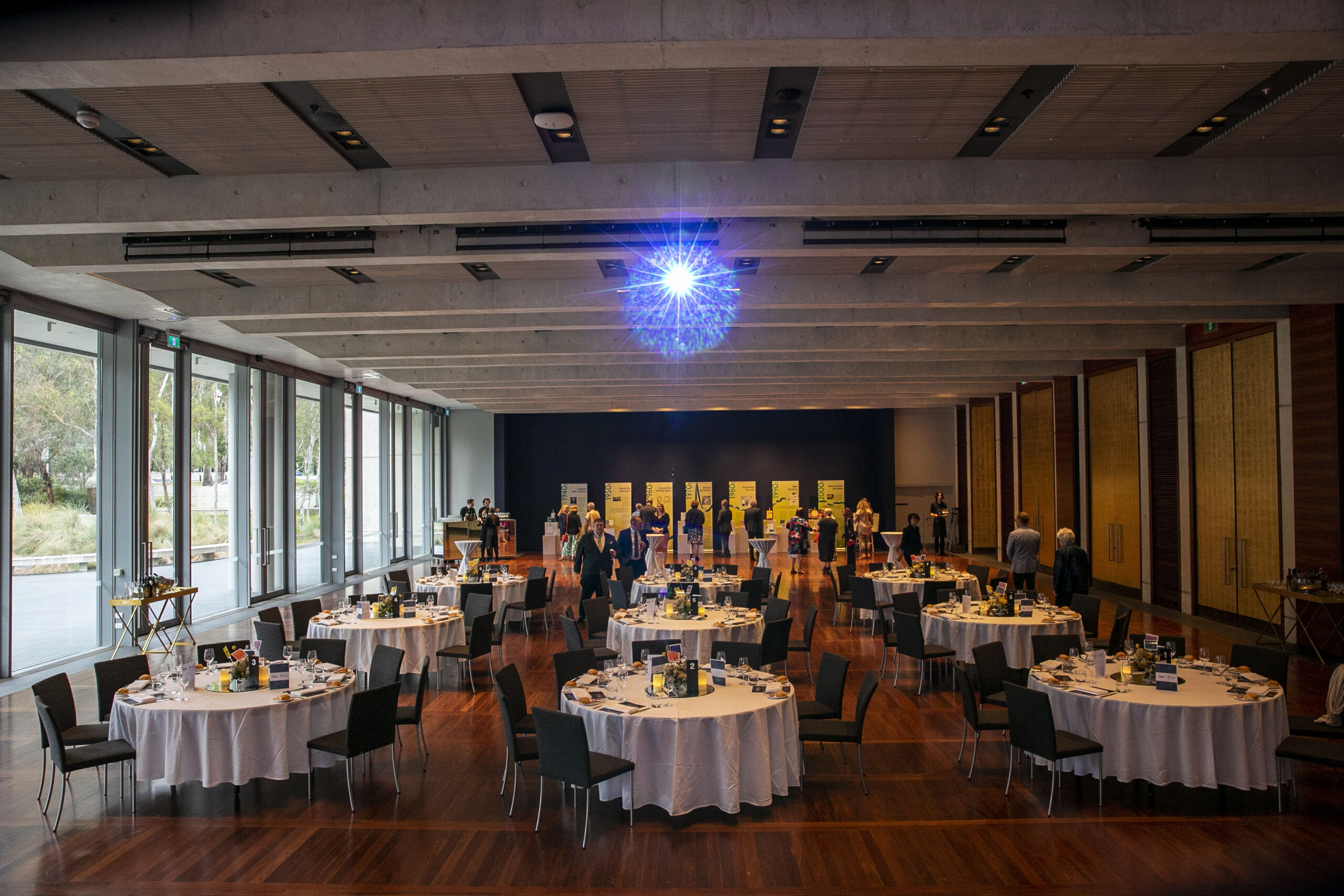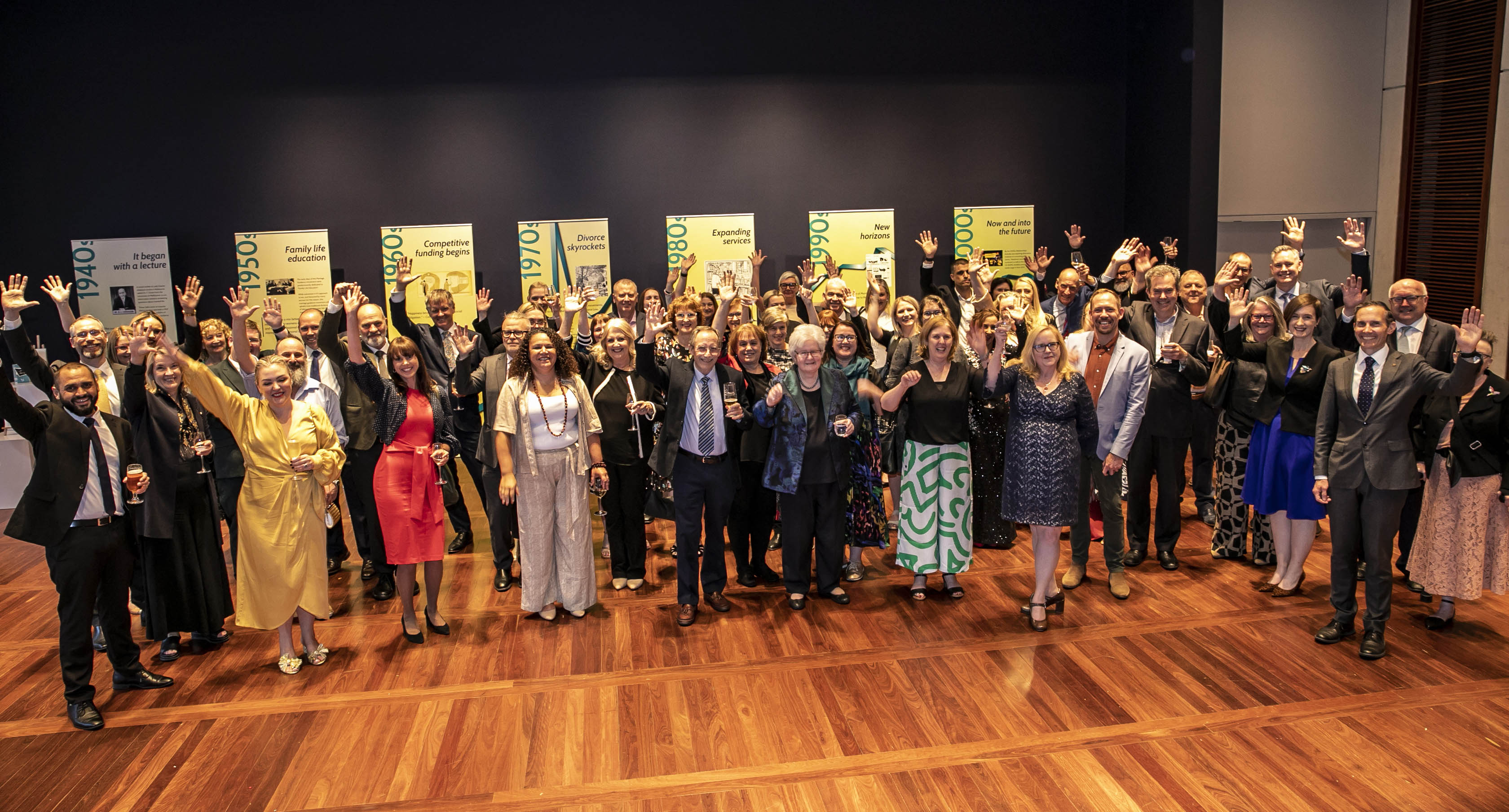How far we’ve come
Explore our interactive history documenting 75 years of Relationships Australia
In November 2023, an exhibition documenting the history of Relationships Australia was installed at a gala event in the National Gallery of Australia, Canberra, to celebrate our 75th anniversary. Seventy-five people were in attendance, including dignitaries such as the Honorable Amanda Rishworth MP, Honorable Dr Andrew Leigh MP and Former Senator George Brandis KC. The exhibition consisted of seven banners and twenty-one artefacts, designed in collaboration with Swinburne University of Technology. Each banner represented one of the seven decades that Relationships Australia has been providing services for, with graphic design ephemera that told the story of how we have evolved to become the service provider we are today. This digital archive provides you with an insight into the exhibition.
Exhibition Introductions
This exhibition was a collaboration between Relationships Australia and Swinburne University of Technology.
Dr Claire Ralfs
Chair of the Board (2023)
I extend my sincere gratitude to all those who have joined us to celebrate our remarkable journey.
Introduction from Relationships Australia
As Chair of the Board of Relationships Australia Inc., I extend my sincere gratitude to all those who have joined us to celebrate our remarkable journey of 75 years in advocating for and supporting respectful relationships. At this significant juncture, it is crucial to reflect upon our history, acknowledge our partners, and chart a course for our future. First and foremost, we must recognise the profound connection we share with the Traditional Owners of the lands where we live and work. We honor the Elders, both past and present, who have guided us and continue to do so. Additionally, we express our appreciation to our Aboriginal and Torres Strait Islander colleagues and community partners, whose invaluable insights and wisdom enrich our mission.
Our inception 75 years ago in Melbourne, as a group of dedicated individuals addressing the pressing need for support for marriages, was the seed from which Relationships Australia Inc. grew. Over time, our mission expanded to encompass a wide range of relationship issues, evolving in tandem with the changing concerns of Australians. This journey is a testament to the commitment of countless individuals who have worked tirelessly to help relationships thrive. They have formed the bedrock of our organisation and are the driving force behind our ongoing evolution.
Our history is intrinsically tied to the broader social and political landscape of Australia. Major cultural movements, including the advocacy for civil rights by First Nations people, women’s groups, LGBTQIA+ communities, refugee movements, and disability advocates, have influenced our service developments. Over 75 years we have adapted and expanded to embrace Australia’s evolving identity.
Today, we proudly stand as an organisation that offers services to all members of the community, regardless of their background or circumstances. Our commitment to inclusivity and our dedication to learning and understanding the unique needs of each family and community are unwavering.
As we showcase our history through this exhibition, we not only pay homage to our past and acknowledge our present, but also reaffirm our commitment to expanding support in the future. Our vision is one where every member of the community can access transformative support services that empower them to overcome relationship difficulties and lead fulfilling lives. In closing, I extend my heartfelt gratitude to everyone who has been a part of this remarkable journey. Together, we will continue to shape a future where relationships flourish, and communities thrive.
Dr Claire Ralfs
Chair of the Relationships Australia Board
Swinburne University of Technology
Dr Jane Connory and Dr Fanny Suhendra
We are grateful for the opportunity to examine Relationships Australia’s transformative journey across the 75 year history.
Introduction from Swinburne University of Technology
As Relationships Australia marks its 75th anniversary, we are grateful for the opportunity to examine the organisation’s transformative journey. From its conception as a marriage guidance movement to its current practice, our research investigates the question; how has Relationships Australia visually represented relationships in Australia throughout this time period.
This exhibition previews our findings on Relationships Australia’s receptiveness as an organisation. Relationships Australia consistently adapted to meet the evolving needs of all Australians in the ever-shifting social landscape. This exhibition, rich with visual representations, features historical documents, brochures, and visual materials to mark this pivotal moment in Relationship Australia’s history.
One of the most prominent themes that will resonate throughout the exhibition is the profound shift from Marriage Guidance Councils to Relationships Australia. This transformation signifies Relationship Australia’s unwavering commitment to placing people at the forefront of its mission. The organisation has recognised that the concept of relationships extends far beyond the confines of traditional marriage and couple relationships, embracing the diverse tapestry of human connections, including friendships and familial bonds.
The artifacts on display will illustrate how the organisation’s services and messaging have progressed in alignment with these core principles. The transition from the term “Marriage Guidance” to “Relationship Australia” was not just a rebranding, but a reflection of the broader scope of the organisation’s mission and the vital role it plays in nurturing and supporting all types of relationships. It serves as a testament to Relationship Australia’s evolution in parallel with the dynamic changes in both global and local society.
Furthermore, the exhibition underscores the organisation’s transformation from its limited representation of Australian diversity at the beginning of its conception into its commendable effort to accurately represent diverse, contemporary Australian lives. The visual choices and the shift towards a more modern and dynamicidentity become evident as Relationships Australia harnesses the power of digital media, incorporating web-based content, social media campaigns, and online resources.
These digital tools now play an integral role in expanding the organisation’s reach and offering crucial support to all Australians. On behalf of Swinburne University of Technology we extend our heartfelt gratitude to Relationships Australia for 75 years of meaningful work, as well as their openness and steadfast support for research.
Dr Jane Connory and Dr Fanny Suhendra
Swinburne School of Design + Architecture
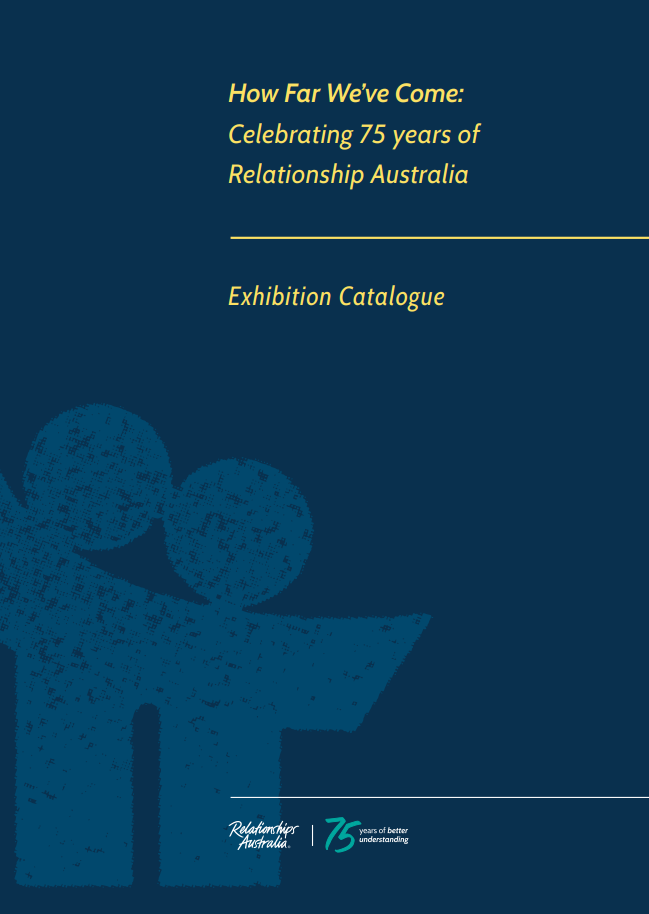
Download the exhibition catalogue
Timeline
This timeline is a digital recreation of the exhibition held at a gala event in the National Gallery of Australia, Canberra, to celebrate our 75th anniversary. You can read more about the exhibition artefacts by clicking on the ‘read more’ button.
1940s

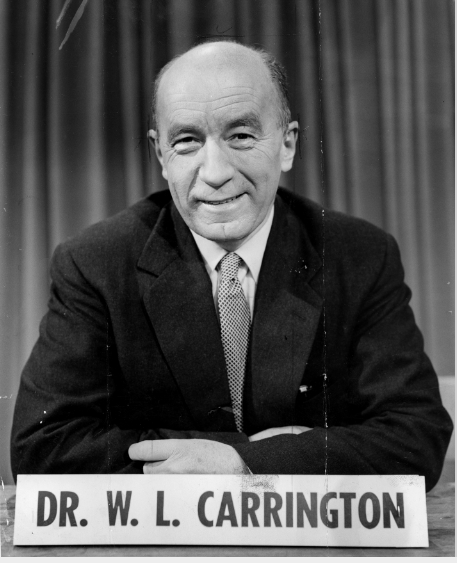
It began with a lecture
According to letters found in the Relationships Australia Victoria archives, Australia’s Marriage Guidance movement began with a social worker at Lady Gowrie childcare centre in Melbourne, asking a university lecturer to run a series of information sessions answering questions submitted by mothers about married life. The popularity of these lectures culminated in a lecture by Dr Carrington, on the “The Find Art of Human Partnership”, which was later published into a booklet by the Melbourne Marriage Guidance.
Photo of Dr. Carrington, Chair of the Melbourne Marriage Guidance Council.
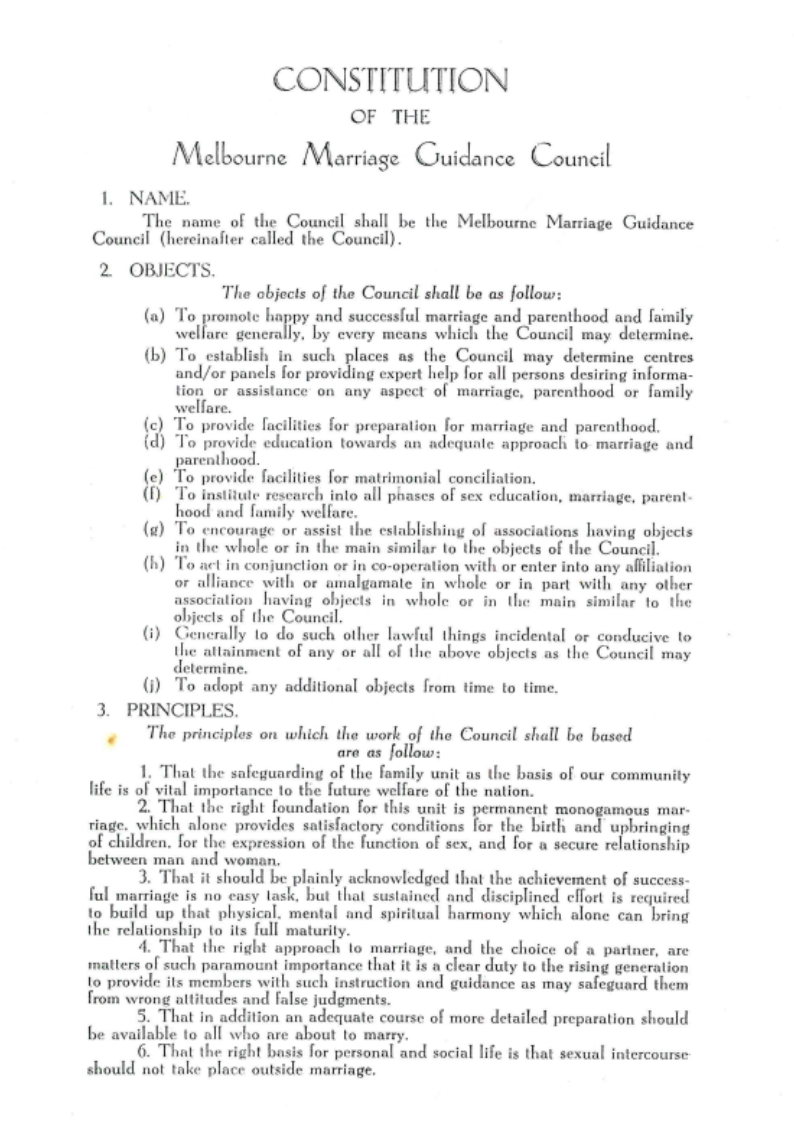
Constitution of the Melbourne Marriage Guidance Council 1948
In November 1949, several gathered in the home of Mrs Kitchen, a leading figure of the movement, to write the Constitution of the Melbourne Marriage Guidance Council. The Constitution of the Melbourne Marriage Guidance Council focuses on several key concerns:
- Promotion of successful marriage through education and guidance;
- Research into sex education, marriage, parenthood and family welfare; and;
- Establishing centres to undertake this work.
Following the popularity of the information sessions at the kindergarten, a meeting was held in 1947 to explore the possibility of bringing the Marriage Guidance movement to Australia. The meeting was attended by around 50 professionals, including social workers, clergy and members of other organisations interested in addressing these social issues. There was significant excitement about the possibility of taking "a scientific approach to one of the worlds greatest problems - the problem of marital relationships".
While Victoria was first, New South Wales and South Australia were very close behind, with a shared focus on educating people on marriage and supporting couples to safeguard the family unit.
Marriage Guidance was popularised in Britain in 1943, following the financial and social stresses of the depression and the war. Concurrently, the Marriage Guidance movement was growing in the United States, based on the influences of Germany’s marriage education movement. Australia was significantly influenced by these movements, especially taking guidance from David Mace, the founder of Marriage Guidance in Britain.
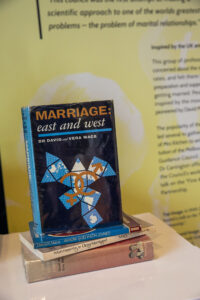
1950s


Family Life Education
The early days of the Marriage Guidance movement were predominantly dedicated to ‘Family Life Education’. Family Life Education involved lectures, later published as booklets, which focused on married life. The tendency to explore sexual problems and issues of sexual adjustment made the lectures popular among young women in new marriages. While subversive in it’s approach to sex, the marriage guidance movement still upheld more traditional divisions of labour, using lectures to discuss a ‘women’s place’ and ultimately felt that marriage was the ideal state.
Photo of marriage guidance council meeting at the home of Mrs Kitchen, 1953.

Towards Successful Marriage
This booklet included a series of articles prepared by the Marriage Guidance Council of South Australia in 1952.

Education for Marriage
This article appeared in the ABC weekly and promoted the arrival of world leaders in the Marriage Guidance movement.
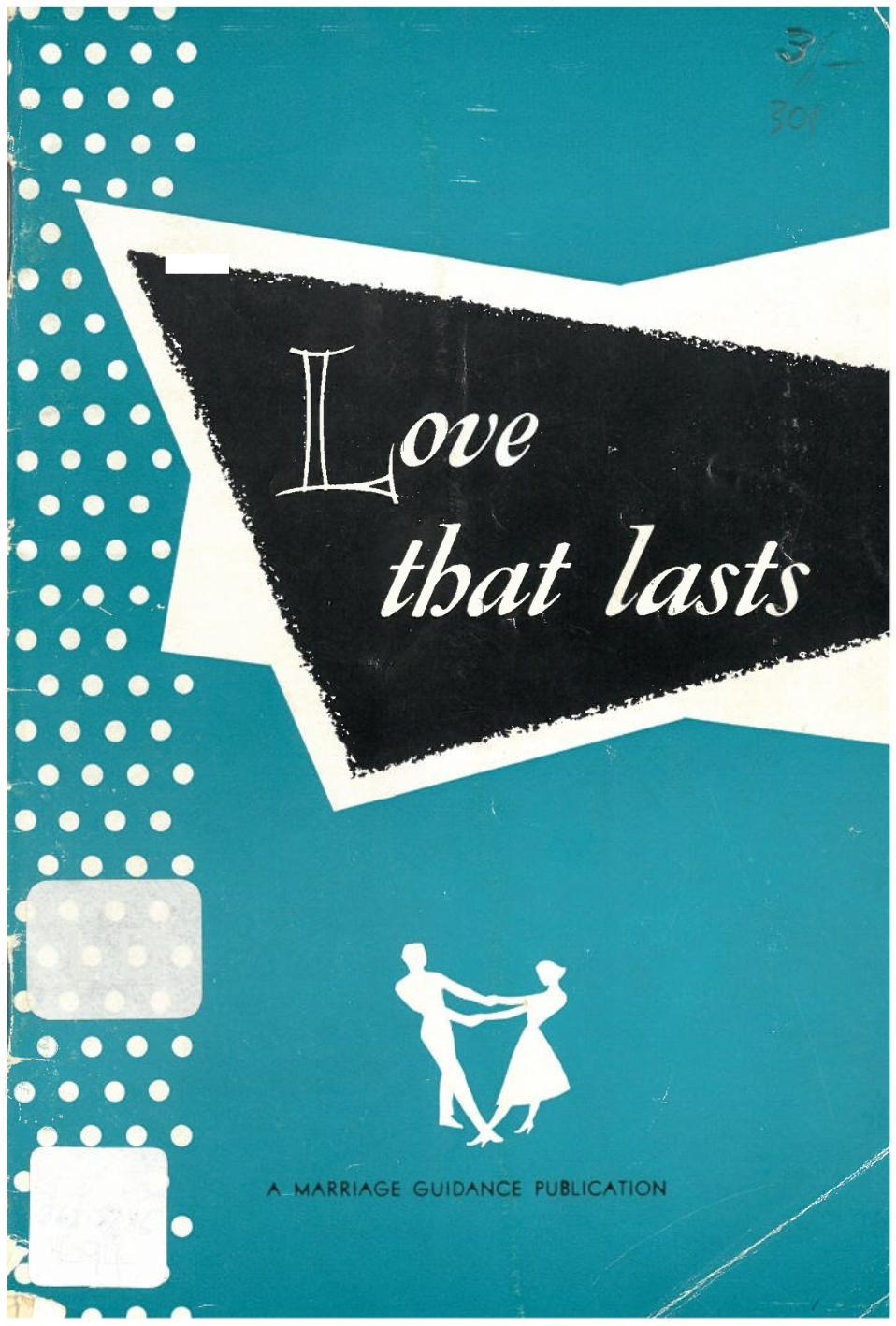
Love that lasts
This booklet focused on learning to love, finding and choosing a partner, courtship and sex and good advice on marriage and how to find it.
Towards Successful Marriage described the establishment of the movement in South Australia and provided advice to achieve a 'successful marriage'. For example, it included editorials on happiness in marriage, the need to pool income, choosing the right partner and “enjoying one another’s little impossibilities”.
“Marriage is partnership. It’s a question of adjustment, patience, boundless love and goodwill. There’s an art in living together which, once learned, bring happiness as nothing else can.”
Love That Lasts is another example of an educational booklet that focused on preventing marriage issues before they arose. This booklet was adapted from a talk hosted by Dr. Carrington, head of the Marriage Guidance Council of Melbourne.
These documents exemplify a key purpose of the Marriage Guidance movement in its early days. While centres were established across the country to support couples, limited counsellors meant that much of the work relied on educating people about marriage before they faced these difficulties.
Education for Marriage, appearing in the ABC weekly, introduced the visit of David and Vera Mace to Australia. Pioneers of the movement in the United Kingdom, their visit increased popularity of the service and led to Federal government funding.
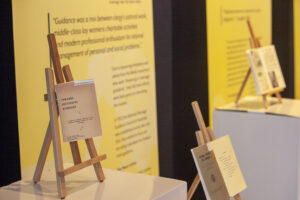
1960s

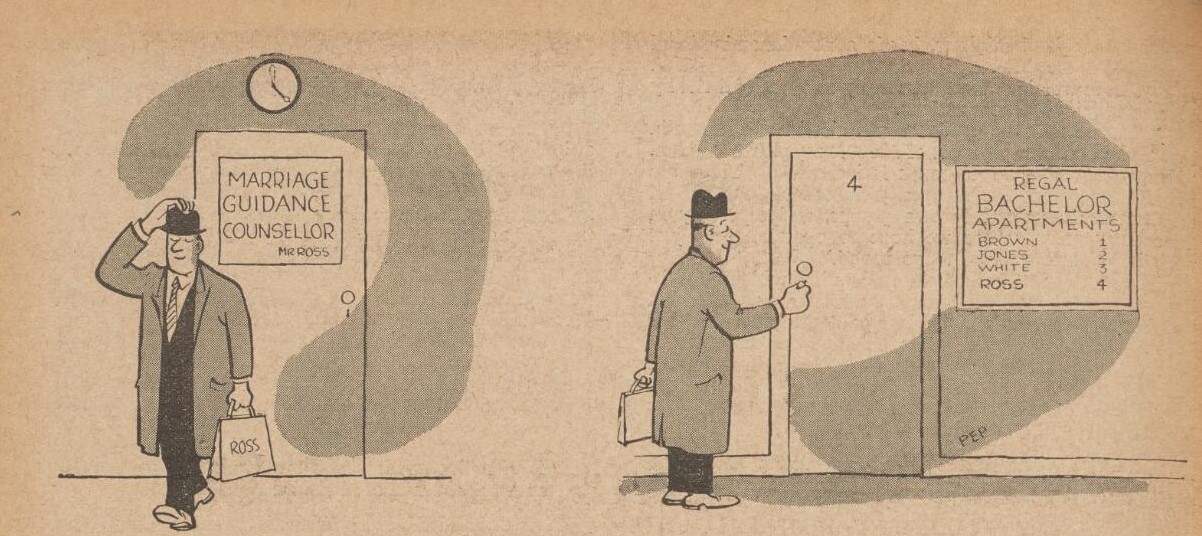
The start of competitive funding
The arrival of competitive funding led to some rivalry among providers. While the Marriage Guidance Council of Australia was slowly shaking its religious roots, Catholic Guidance centres remained steeped in tradition. The Attorney General’s Department who were funding the services, urged organisations to merge, however this was resisted as organisations had different approaches to the work.
For example, this cartoon from ‘The Bulletin’ illustrated the growing concerns about bachelors giving marriage guidance in more progressive organisations.

Focus on Marriage Guidance
“Focus on Marriage Guidance” collated articles on key issues for emerging guidance practices, including social shifts, legal issues, educational work and the incorporation of psychology and counselling techniques into the work.
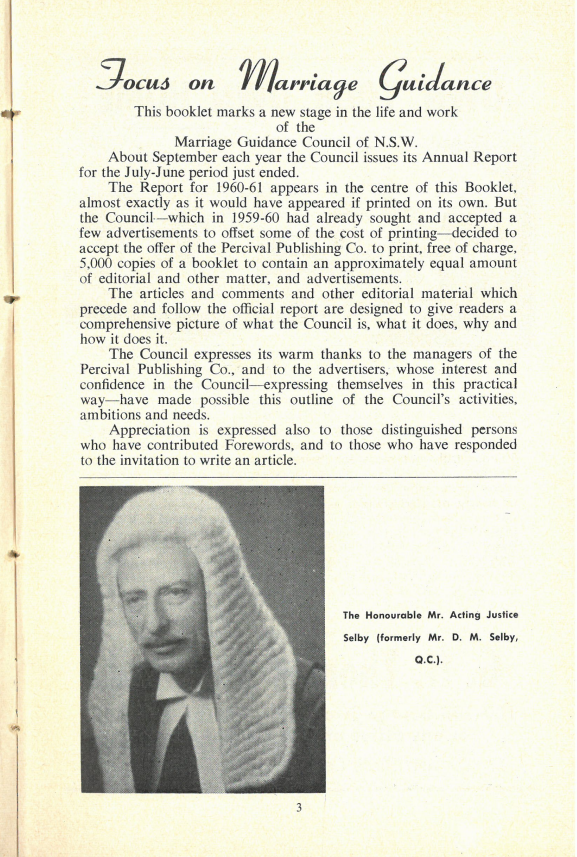
Introduction to ‘Focus on Marriage Guidance’ by the Honorable Mr. Acting Justice Selby, 1961.
Justice Selby was involved in divorce reformation and wanted to ensure equal rights for both parents and more attention to be paid to the welfare and custody of children.

Annual Reports 1960s
Annual reports throughout the 1960s illustrated a shift from an emerging field into a more established one. Guidance Councils were interested in growing membership, increasing awareness of their work and refining exactly what their role was in society.
The Marriage Guidance movement was fractured further by the social environment of the 1960s. The shifting attitudes towards marriage, sex and social conformity, as well as the rise of psychology all affected the delivery of the service.
By this stage, Marriage Guidance movements in the United States and Britain had diverged. The United States consisted of highly trained, professionalised paid workers, while Britain was solely volunteers providing advice based on personal experience and social mores. Counsellors in the US began to integrate psychological approaches into their practice, particularly focusing on self-actualisation in the context of shifting social understandings of the purpose of marriage.
In response to conflicting approaches, in Australia, the movement began to be professionalised. Traditionalists focused on the continued need for family life education. Progressives felt there was a need for guidance workers to grow with the client, focusing on emerging psychological practices such as interviewing couples together. As a result, selection, training and supervision changed and began to formalise the previously implied skills of empathy and listening. Marriage breakdown began to be understood as stemming from a mismatch of individual psychology as opposed to something which could be prevented through education and guidance.
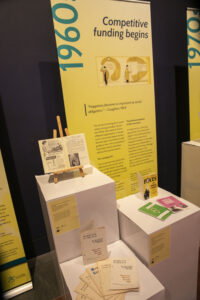
1970s


Divorce skyrockets
In 1974 the Royal Commission into Human Relationships and fervent campaigning by women’s movements, led to the introduction of no fault divorce law through the Family Law Act which passed in 1975. A huge backlog led to around 65,000 divorces and 1975 remains the year with the greatest number of divorces still today.
Demonstrations for no fault divorce law took place during the Royal Commission, with petitions for signing, Civic Plaza, Canberra, 1974.
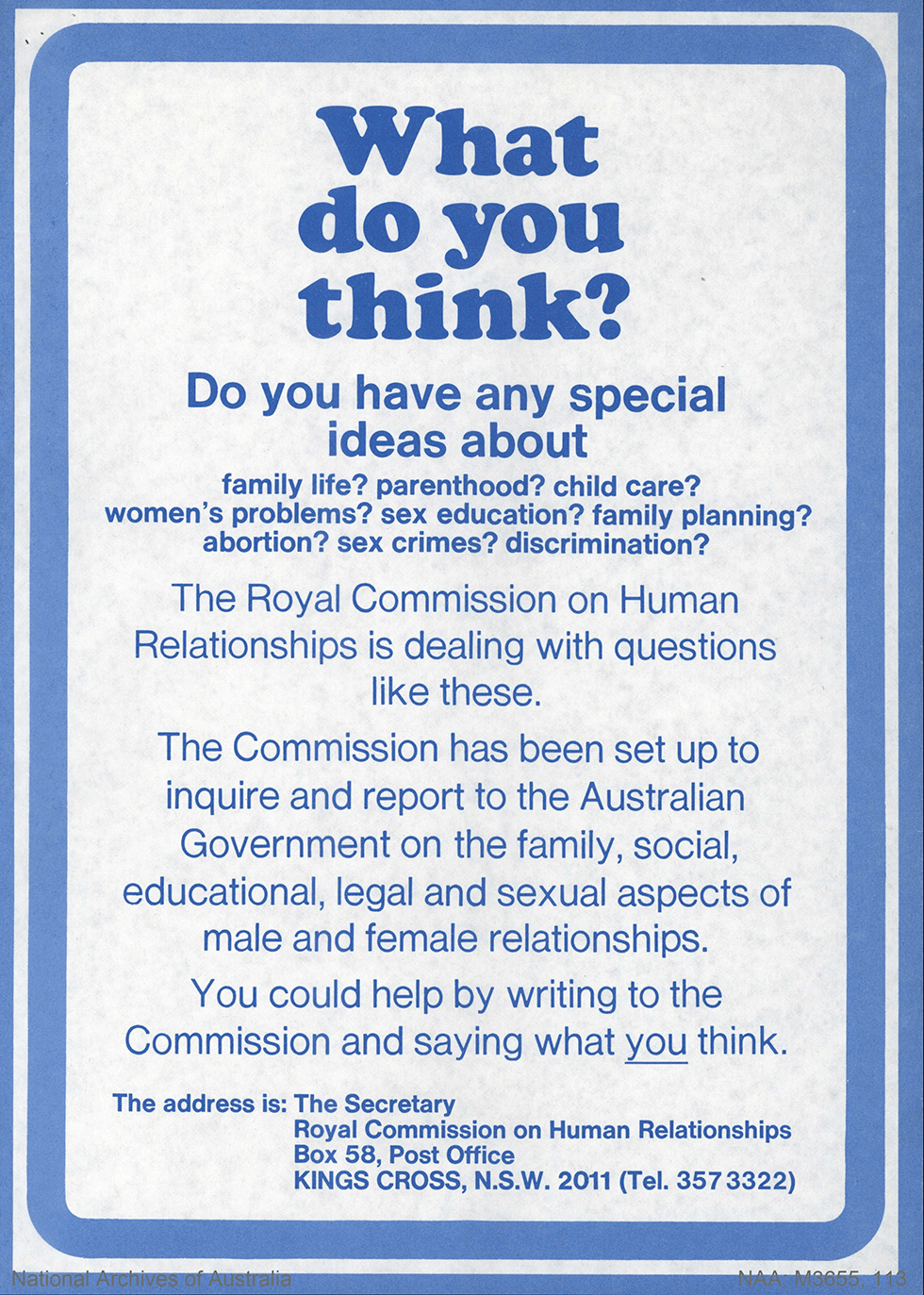
What do you think?
This leaflet was distributed widely, inviting the public to contribute to the 1974 Royal Commission on Human Relationships. The terms of reference included sexuality, family violence, gender inequality, family planning and divorce.

Divorce Dilemma
Dr Hartin was the Director of the Marriage Guidance Council of Victoria. He wrote Divorce Dilemma in the wake of No Fault Divorce Law to help people navigate their failing marriage. It reframed failed marriages as a societal issue, as opposed to a flaw of the couple.

Orange Blossom Light
This poem was printed in The Woman’s Weekly. It was a response to a suggestion, posited at the National Marriage Guidance Conference, that people should have their emotional and financial affairs in order before considering marriage.
The funding that became available in the early 1960s for marriage guidance, as well as the conflicting approaches to the work that were emerging, led to a formalisation of the work. Specifically, many roles became paid positions. By the 1970s, the effects of this were felt across organisations. The decision to employ counsellors, as opposed to relying on volunteers, meant there were fewer counsellors and more work for each counsellor to do. The reduction in volunteers also led organisations to ask clients to pay for the first time. The movement had been professionalised.
Training intensified and the shifting role of the counsellor meant they were no longer volunteers providing guidance, but trained counsellors providing therapeutic intervention. The 1970s saw the birth of what we now understand to be relationship counselling. Family Life Education, which had always made up a significant part of the role, shifted from divorce prevention towards therapeutic groupwork. With No Fault Divorce Law and the mass rise in divorces, the focus of the organisations became much more about supporting couples through divorce, as opposed to supporting couples to preserve their marriage.
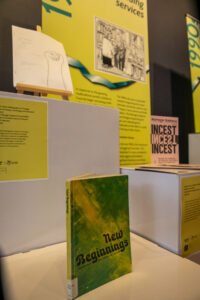
1980s


Expanding services and changing needs
By the 1980s the concept of marriage guidance has shifted and expanded radically. Funding was mostly provided for couples to navigate relationship breakdown safely and respectfully, as opposed to guidance on how couples could stay together. The services reflected a cultural shift towards divorce following 1975.
Despite this, the ongoing denunciation of divorce by religious groups received criticism, as illustrated by this cartoon by Geoff Pryor, from the Canberra Times, 1982, commenting on the Popes strong standing on divorce, in comparison to the shifting social mores.

Incest in families: Its effects and help from counselling
The British Marriage Guidance Council released quarterly journals during the 60s, 70s and 80s exploring issues in the profession. The 80s saw a significant shift, bringing previously taboo topics into the light and providing counselling and other support to victims of sexual and family violence.

New Beginnings
This book about separation and divorce was collected from the Relationship Australia Victoria library. It reflects the growing social acceptance of divorce that emerged during the 80s. This accepting attitude was evident in a variety of publications and therapeutic approaches from the Marriage Guidance councils across Australia.

Domestic Violence Booklet
The emerging recognition of domestic violence in the late 1980s was in major part due to feminist movements who highlighted the plight of women in violent relationships and called for services, such as Marriage Guidance Councils, to evolve from a marriage preservationists into a service agency supporting women to access safety.
Feminist movements criticised marriage guidance practices for encouraging women to stay in violent marriages, or at the least, being unqualified to respond to domestic violence situations. Marriage Guidance Councils began spending significant time and effort educating and training staff, however as an emerging field, very little evidence was available at the time on the best practice to respond to these situations.
Additionally, during the 1980s services began responding to the growing multicultural society. Guidance Councils began recruiting multicultural counsellors and government funding also became available for counselling programs targeting Italian and Greek communities.
The huge rise in divorce from 1975 onwards led governments to begin funding more mediation services, which the Marriage Guidance Councils provided. The Guidance Council also began evaluating supervision practices to explore how the professionalisation of these services has impacted its effectiveness.
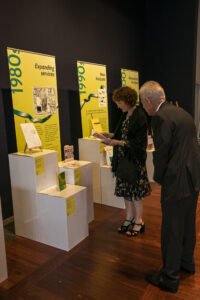
1990s


New horizons
In 1993, the federation of Marriage Guidance Councils voted to rename to Relationships Australia in alignment with a growing service offering for couples, families and communities. This excerpt from a booklet marking the change in name illustrates the broadening of services, well beyond the limitations of ‘marriage guidance’.
Brochures courtesy of Relationships Australia South Australia.

Changing relationships
This book marked the change of name from “Marriage Guidance Council” to “Relationships Australia”. It outlines the history of the organisation and its ideological shifts that took place to situate it to become a relationship service provider across the public health, mental health and legal sectors.
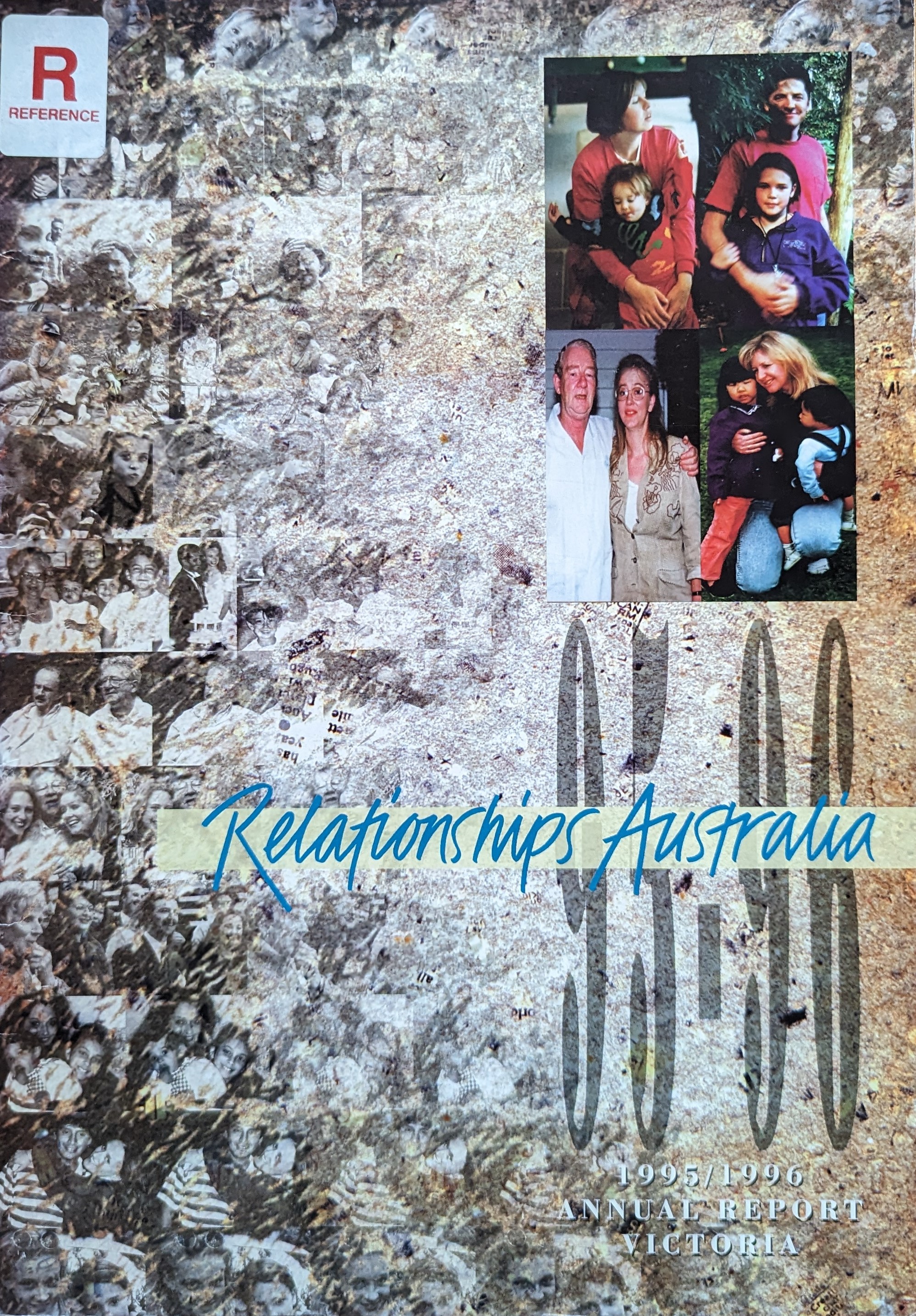
Annual Reports
Annual reports from the 1990s chronicle funding issues, as the expanding service offerings and new training requirements are not appropriately supported by funders. Visually, we can see the clear shift from couples and marriages to other familial and collegial relationships.

Papers to Celebrate 50 Years of Relationships Australia
The book collated essays by prominent Australian figures to celebrate 50 years since the National Marriage Guidance Council was established, now known as Relationships Australia. Visually, this period marks a clear focus on family relationships.
During the 1990s, Marriage Guidance continues to expand its work outside of the focus on the couple. They begin releasing research and programs targeted at exploring the effect of relationship breakdown on workplaces. While children and teenagers have been a focus of Family Life Education throughout the 20th century, specific services targeting children emerge in the 1990s. For example, the effect of separation on children was a key focus of mediation services. Other services which were popular in the 1990s included community development work, gambling prevention, children’s contact services, Veterans support, child abuse programs and employee assistance programs.
Conferences were popular during the 1990s as the family and relationships sector emerged. In 1992 marriage guidance counsellors attended the Summit on the Family in Canberra. In 1998, to celebrate 50 years of Marriage Guidance in Australia, Relationships Australia hosted a conference on domestic violence in New South Wales. Family Law conferences were also an important date in the calendar, as well as educators conferences, exploring the ever-expanding education services provided by the Councils. A book of essays released in 1999, to celebrate 50 years since the National Marriage Guidance Council was established focussed on concepts such as same-sex couples, gender and men, changing family structures, working mothers and the concept of marriage going out of fashion.
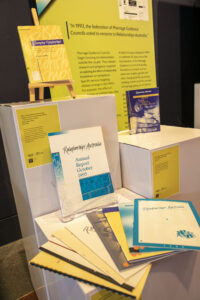
Access the exhibition catalogue
2000s


Now and into the future
By the 2000s, Relationships Australia was exploring alternative methods of connecting with clients. Telephone counselling continued, as well as the use of CD-ROMS, booklets and social media usage from 2012. Relationships Australia showed their support for social movements that affected their clients, such as marching in the Mardi Gras parade.
Relationships Australia marched in the Mardi Gras parade, 2014.

Building Better Relationships
Relationships Australia continues working as a service agency and provides a variety of resources and materials to help Australians with their relationships. The 2000s saw a diverse range of support materials and an exploration of alternative methods to connect with clients. This included telephone counselling as well as the use of CD-ROMS.
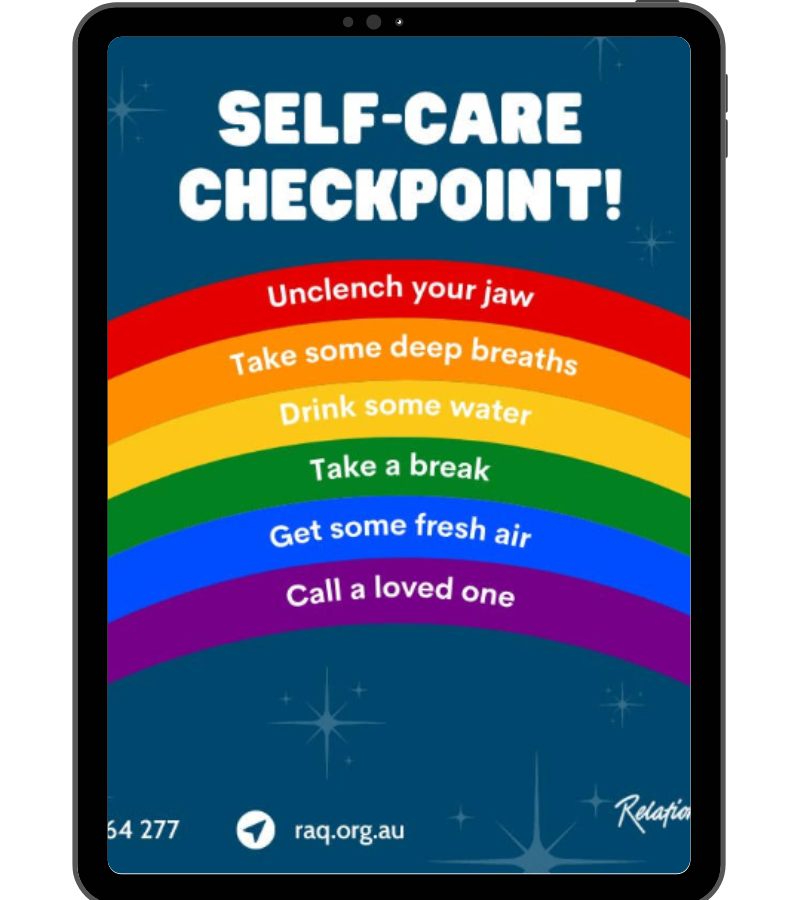
Social Media
Relationships Australia began engaging with social media in 2012, showing a commitment to becoming more inclusive and diverse in both its service offerings and visual representation. The current service offerings support all kinds of relationships, including LGBTQ+ communities, First Nations peoples as well as Culturally and Linguistically diverse families. This diversity of services is evident in the social media posts.
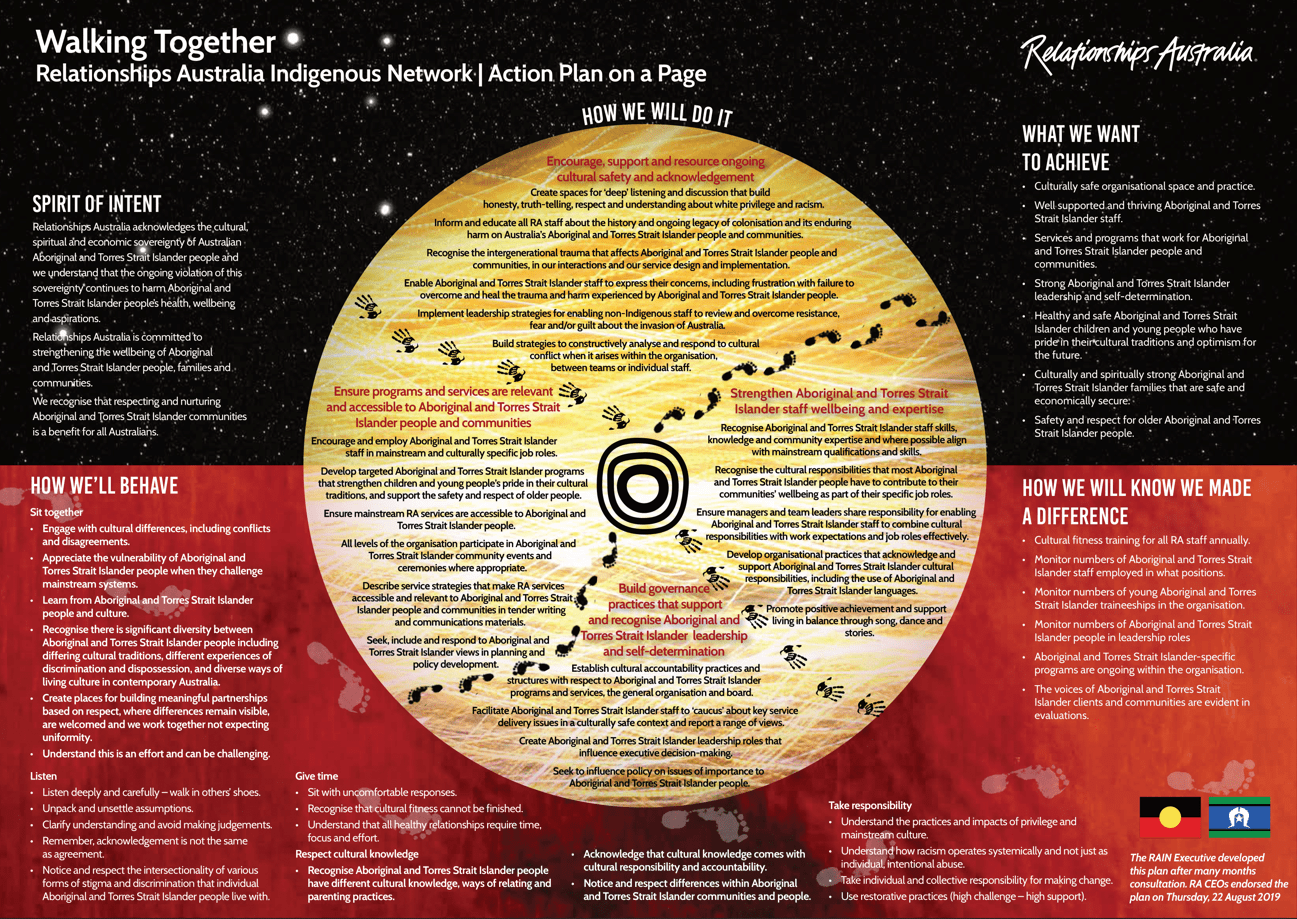
Relationships Australia’s Indigenous Network and the development of the Action Plan on a Page
Relationships Australia’s Indigenous Network was established in 2007. The Action Plan on a Page was developed by the network and demonstrates a commitment to strengthening the wellbeing of Aboriginal and Torres Strait Islander people, families and communities and the work that must occur across the Federation to do so. The Action Plan on a Page is a foundational piece of work that continues across the Federation.
The 2000s also saw Relationships Australia’s foray into social connection work on a population-based level. In 2003, the first annual “check on your neighbour day” took place in Victoria, Australia, founded by Andrew Heslop. This grew into the campaign Neighbour Day, gifted to Relationships Australia in 2014 and now known as Neighbours Every Day, Relationships Australia’s social connection campaign.
In 2006, Relationships Australia was funded to begin operating over 30 Family Relationship Centres across Australia, providing government subsidised support services for forming new relationships, overcoming relationship difficulties or dealing with separation. Family Relationship Centres reflected a growing commitment from the government to support respectful relationships across the lifespan.
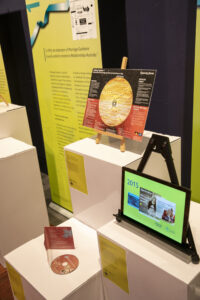
Exhibition Photographs
Scroll through exhibition photographs below by clicking on the arrow
Exhibition curators and designers

Dr Jane Connory (Glover)
has curated many exhibitions as part of her research exploring visibility, inclusivity and diversity in design.
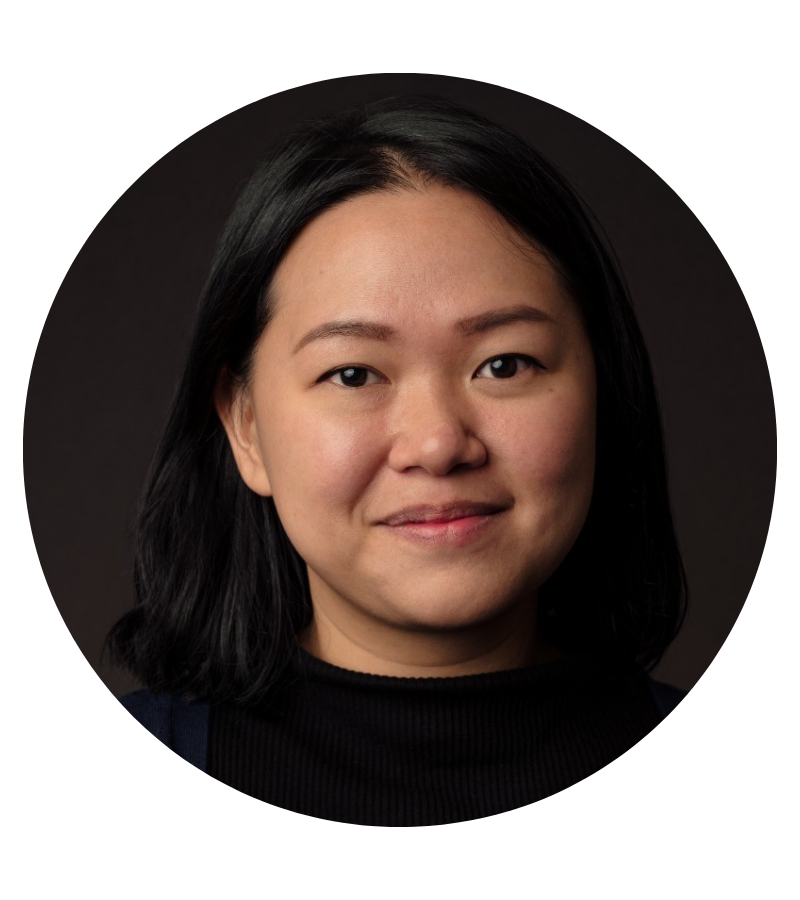
Dr Fanny Suhendra
Her work focuses on decentering canonised design knowledge through self-reflective approaches in design education and practice.
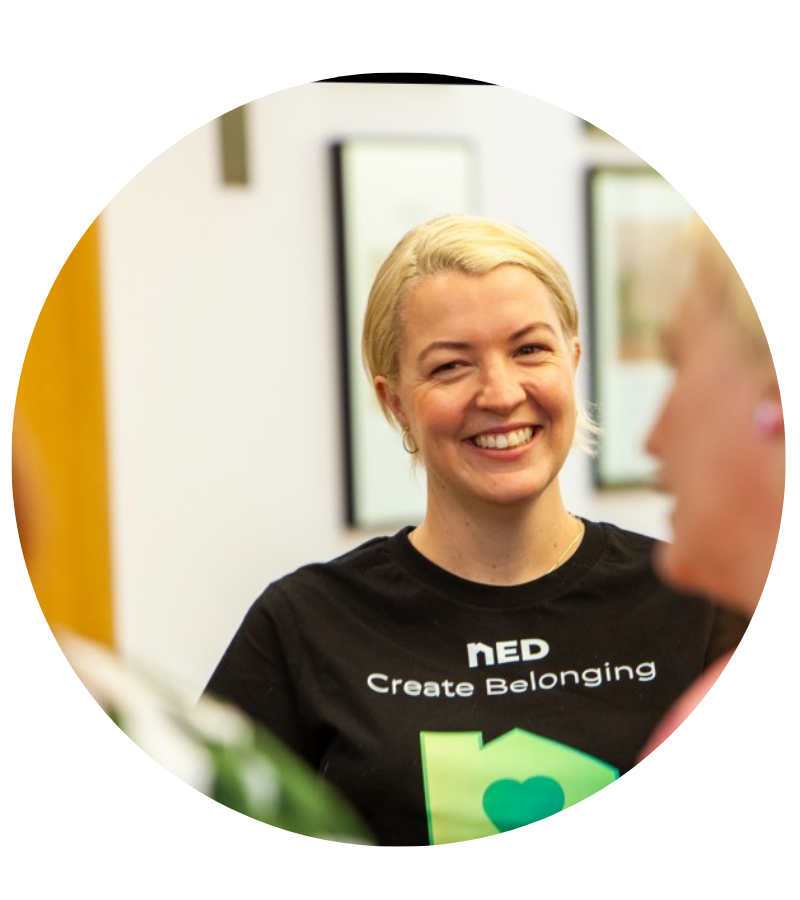
Claire Fisher
National Research and Projects Manager at Relationships Australia, she works to create exciting opportunities for new research across the Federation.

Dr Jane Connory has curated many exhibitions as part of her research exploring visibility, inclusivity and diversity in design. She is a lecturer at Swinburne University’s School of Design + Architecture and has held positions as the National Head of Research at the Design Institute of Australian, the Vice President of Creative Women’s Circle and Coordinator of the Emerging Scholars Workshop at the Design and Culture, Francis and Taylor journal.
jconnory@swin.edu.au

Dr Fanny Suhendra is a design researcher and educator in Indonesia and Australia. Her primary research focuses on the relationship between graphic design and its role as a behavioural change agent through the consideration of localised knowledge, intersectional diversity and inclusivity. As a Chinese-Indonesian designer educated in the West, she notices that hegemonic Western views present a lack of communication design identity and ownership in some non-Western communities. Her work focuses on decentering canonised design knowledge through self-reflective approaches in design education and practice as well as collaborative international research.
fsuhendra@swin.edu.au

Claire Fisher is the National Research and Project Manager at Relationships Australia National. With a research background in anthropology, she works with people across the Federation to create exciting opportunities for new research in a variety of fields. She has a passion for knowledge translation to create a stronger pathway from research to practice and recognises the need to explore a variety of research disciplines to understand our past and improve the quality of our services for the future.
